Behind the scenes with Facebook at the first Democratic debate
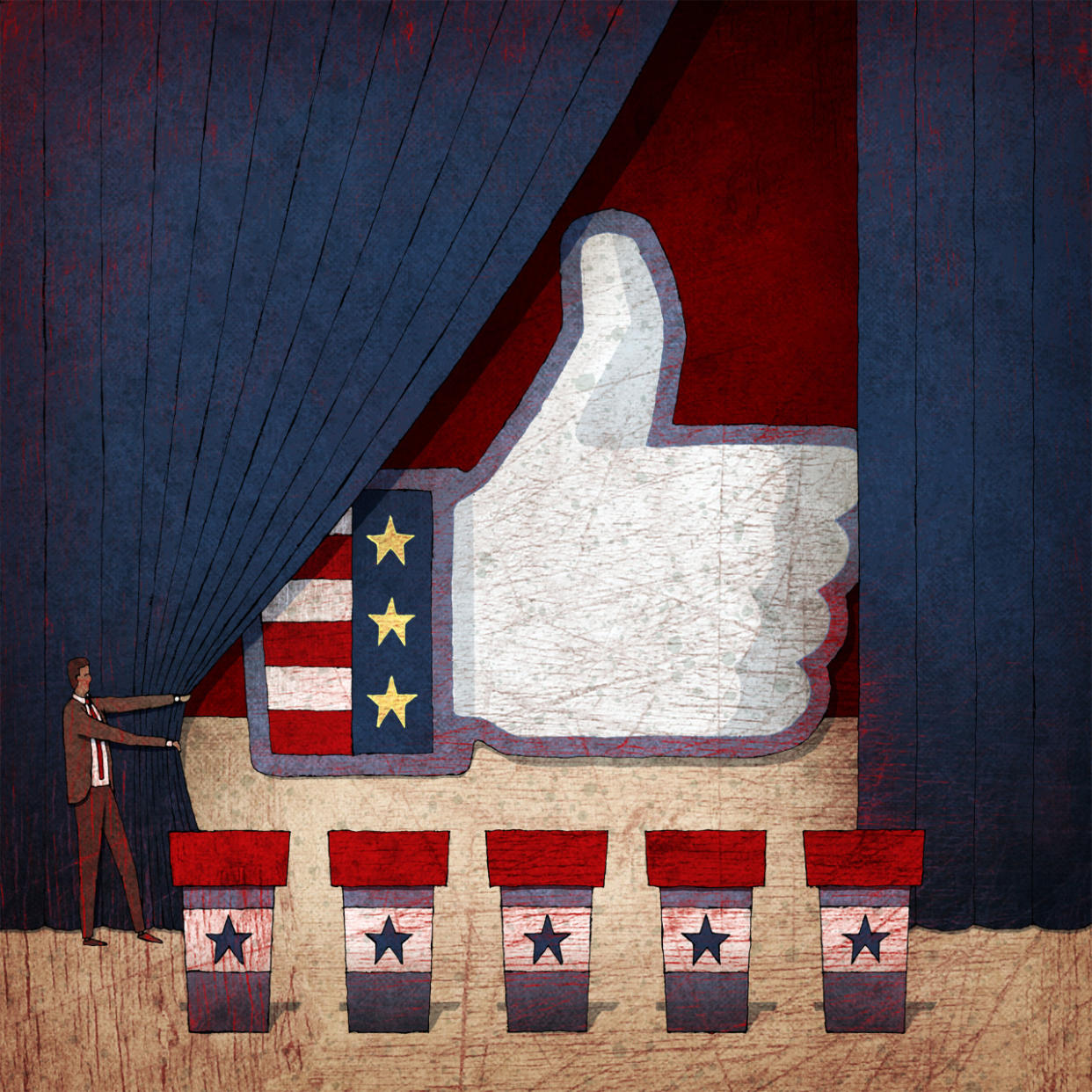
Illustration: Jesse Kuhn/rawtoastdesign.com for Yahoo News
First and foremost, Facebook’s elections team needed to brand the hell out of everything.
That meant the napkins, the tabletops, the pens, the tote bags, the pins, the coffee-cup sleeves, the custom-made Rubik’s Cubes, the selfie sticks, the pillows in the form of the donkey symbol that Facebook offered online for Democratic-debate-related check-ins. Even the carpet.
“We matched it to the closest Pantone color of the teal in the Facebook Elections logo,” Katie Harbath, the company’s upbeat global politics and government outreach director, told me as we toured Facebook’s chic lounge area at the first Democratic debate in Las Vegas, which was co-sponsored by CNN and Facebook. Even her dress, the color of the Facebook logo that flashed on millions of Americans’ screens Tuesday night, complemented the surrounding decor.
Harbath was one of 40 Facebook employees who flew to Nevada the weekend before the debate to set up what would become an oasis of tech-company cool in a corner of the Margaux Meeting Room at the Wynn Hotel. Despite the lounge’s close proximity to the frenzied on-location TV sets of major television networks like Fox, MSNBC and CNN in the spin room, the Menlo Park, Calif.–based company sought to project an airy, modern atmosphere.
“If we had just had this orange carpet in here” — she said, gesturing to the hotel’s floor, a vast Creamsicle-toned expanse — “it wouldn’t look as nice. If you want to have a really good experience, you need that all-inclusiveness.”
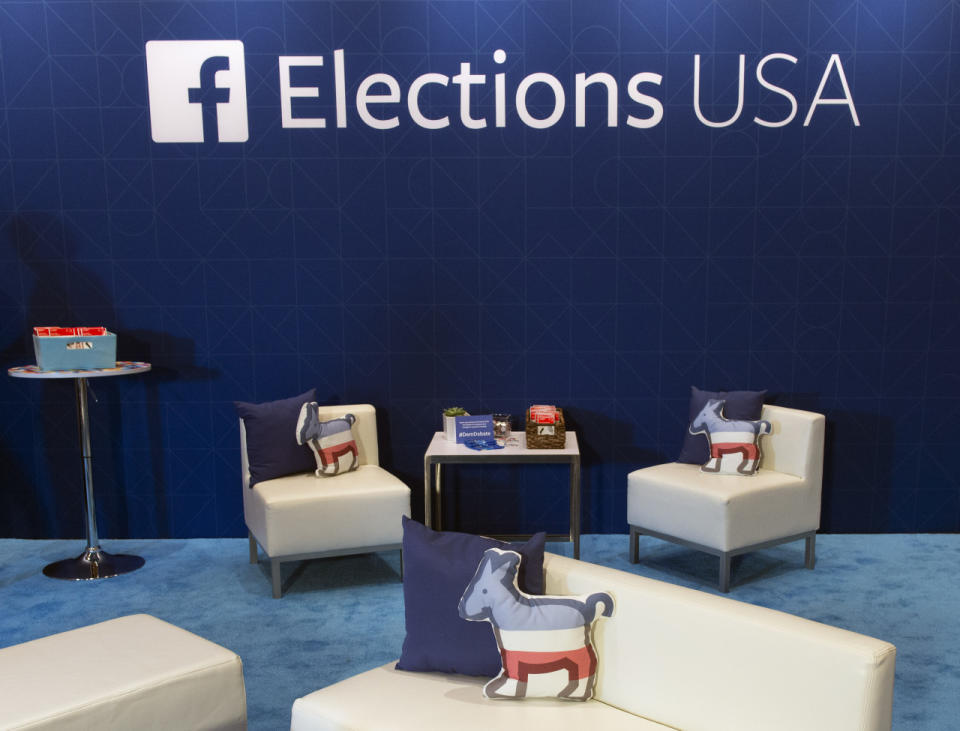
The Facebook Lounge, complete with pillows that several journalists stole. (Photo: Brian Cahn via ZUMA Wire)
Harbath’s goal for the furnishings could double as a slogan for Facebook’s fast-growing, elections team. Its sole purpose, since it was assembled for the 2012 presidential election, has been to turn Facebook into a global, all-inclusive destination for political news and a major medium for political participation, engagement and conversations. And while Facebook says this is all about promoting a healthy political discourse, the company is also using its detailed understanding of the electorate and targeted messages to make money in what has become a major cyclical online market. Some estimate that the company will rake in $1 billion for political advertising over the course of the 2016 election cycle.
Facebook does this all with a core 20-person team of data and communications pros, outreach coordinators for Democrats and Republicans, partnership negotiators and a political ad-sales team. Since candidates began declaring their intention to run for president in the spring, Facebook has facilitated a record-breaking 68 million people discussing the presidential debates on Facebook and more than a billion interactions — likes, comments and shares — blowing past earlier company landmarks such as the 2014 midterm elections and the 2014 Brazil presidential election — the most talked-about political moment on Facebook ever prior to this year.
These statistics solidify Facebook’s place as the most widely used and powerful digital tool in U.S. politics. The company, originally created to rate the hotness of Mark Zuckerberg’s Harvard classmates, now wields an impossible-to-ignore influence within the world’s most important democracies.
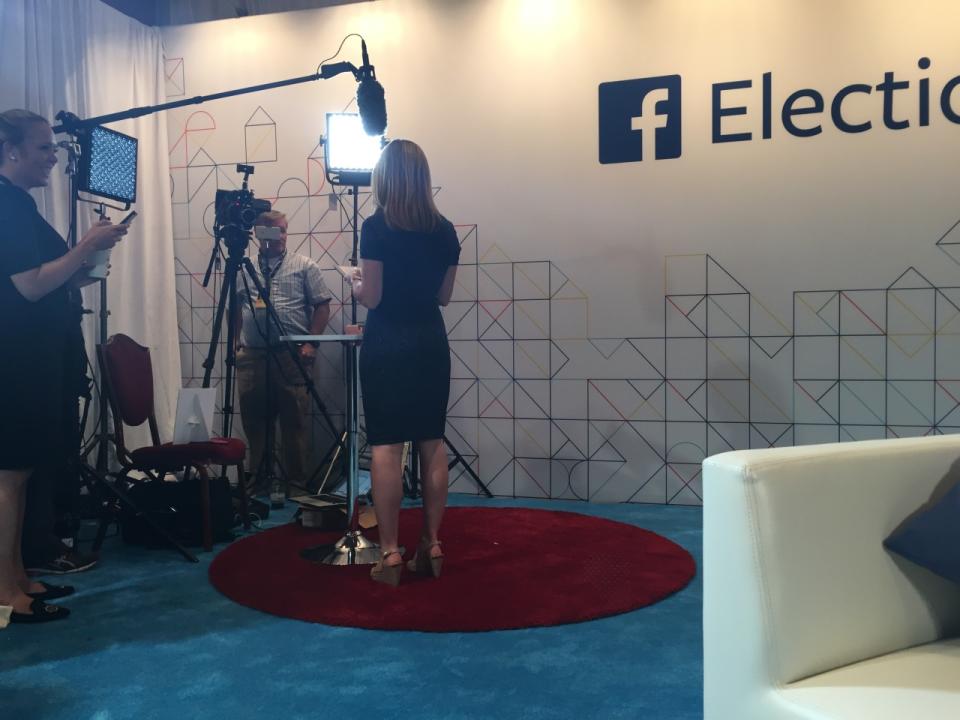
Visitors to the Facebook Lounge were encouraged to answer questions about themselves on camera and post the footage on their Facebook page via the Mentions Live app. (Alyssa Bereznak/Yahoo News)
The Facebook Elections team and budget weren’t always so robust. Though the 2008 presidential race was unofficially known as the “Facebook election,” that had more to do with the Obama campaign’s grassroots digital organizing on the platform and less to do with products that the company itself was developing for the purpose of fostering a lively online political discourse.
Back then, Facebook’s most memorable contribution to the election was the inclusion of an “I’m voting” button at the top of people’s Facebook pages on Election Day. It lacked the infrastructure to easily offer sophisticated statistics on what issues really mattered to voters and who was voting — data that’s invaluable to campaigns. Even when Harbath joined the company in 2011, after serving as chief digital strategist at the National Republican Senatorial Committee, her team consisted of about five people, and mobile ads were nonexistent.
“I was setting up the Internet and laying down the carpet at conventions,” recalls Harbath. “I was there all by myself.”
Today, however, every like, comment or post about politics in the Facebook universe is used to push forward both the company’s influence and the national conversation. Not only does Facebook allow campaigns to anonymously track the consumption habits of their most loyal supporters, its data team can drill down to who’s saying what about which candidate on the state and county level.
It’s a complicated process that mixes data analysis with political insights into what’s worth tracking.
Harbath’s team first began prepping to monitor the 2016 debate conversation in early January, brainstorming all the key terms expected to pop up while people were posting about candidates.
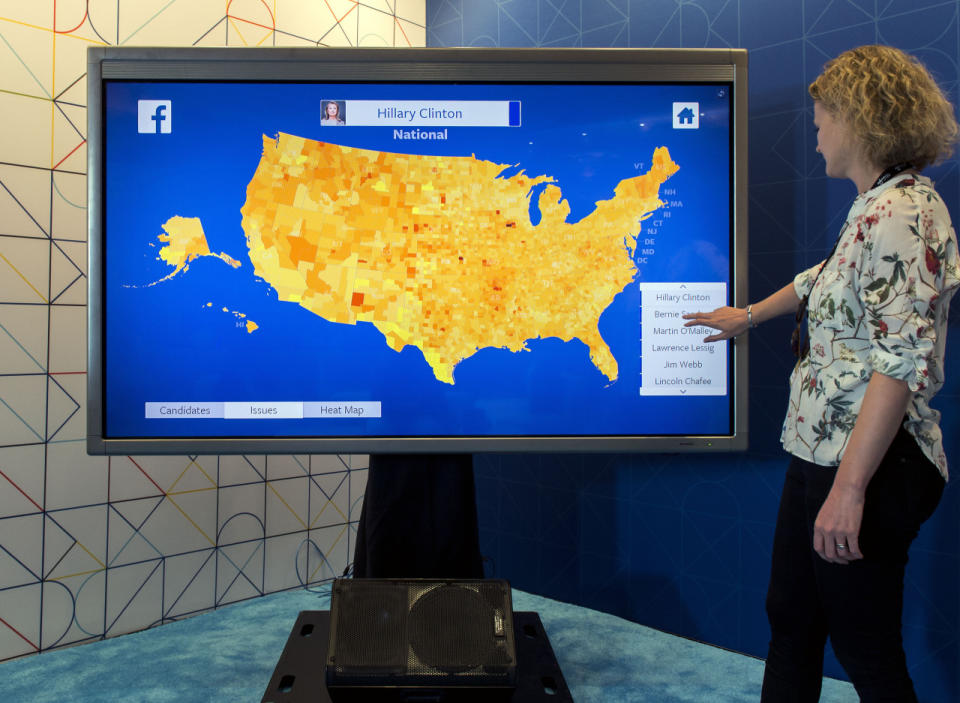
The interactive data touchscreen in the Facebook Lounge. (Photo: Brian Cahn via ZUMA Wire)
First came the names. The team threw every remotely possible potential candidate into their famously secret data-analysis systems, missing only Lincoln Chafee and Lawrence Lessig in the generous net it cast. That way, when anyone posted to Facebook about those politicians, a built-in algorithm would automatically count it as a unique mention for the candidate and add it to a larger tallying system that Facebook uses to measure each candidate’s popularity online.
Issue tracking came next. What were the key terms people would be using to talk about the 2016 campaign’s most urgent talking points? The elections team started with big-picture categories like “labor” and “education,” then broke each category down into granular subtopics that resulted in what Harbath says is “a massive list.” Those terms were also coded into the mysterious Facebook algorithm, and as each new story breaks — such as the Umpqua Community College shooting in Oregon earlier this month — more topics are added.
“We came up with this really expansive taxonomy,” Harbath said. “We’re always adding new issues as things come up.”
All this means that, come debate night, anything your grandma, co-worker or fascinating high school friend posts on Facebook is automatically analyzed in three separate layers:
1. Whether a Facebook user references the debate at all.
2. Whether the user mentions the name of someone in that debate.
3. The appearance of key issue terms like “the economy” or “terrorism.”
Like a series of pneumatic tubes, each segment of a sentence is sucked into its own lane and deposited in its rightful database.
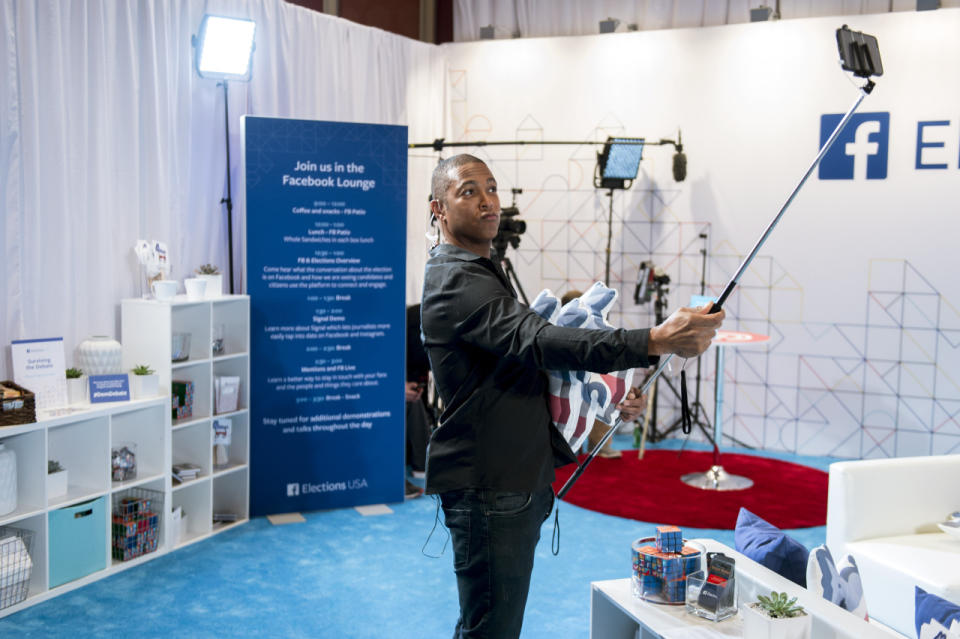
CNN’s Don Lemon wields a selfie stick in the Facebook Lounge. (Photo: Brian Cahn via ZUMA Wire)
Facebook, in turn, uses all this information to illustrate the story of a debate night as it unfolds. If Twitter is the place to go to see a viral moment live and die within a few hours, Facebook has positioned itself as the authoritative voice on what resonated with the majority of Americans.
Facebook’s data editor Robert D’Onofrio calls it a “beautiful water-cooler effect.”
“We really do feel like this is the election where Facebook is replacing that traditional town-hall format and enabling civic engagement and discourse that’s across the spectrum of opinion,” D’Onofrio told me outside the Wynn. We sat on stools at a Facebook-branded table on a wide, covered veranda the company had turned into a continuation of its spin-room lounge and where throughout the day it served a rotating array of foods and beverages in red, white and blue. Alongside the themed snacks was everything from breakfast parfaits to chilled Red Bulls. Inside the lounge, a display adorned with potted succulent plants framed two baskets, one full of Emergen-C packets, the other Advil, to help weary journalists survive the day’s exhausting media blitz.
But D’Onofrio and the rest of his data-mining team spent much of Tuesday away from the blue-and white-lounge, ceding it to on-air personalities such as CNN’s Don Lemon and Jake Tapper and teams of visiting journalists eager to learn about new features Facebook is rolling out. Instead, the data miners camped out in a satellite room.
By debate time, the entire 40-person group had settled in with them in the plain-orange carpeted regular room, kicking off their heels and ordering a few bottles of white wine. Surrounded by cardboard boxes of excess swag, they typed away on their glowing MacBooks and ThinkPads, scribbling ideas onto notepads each time a candidate made an important policy point.
They cheered when moderator Anderson Cooper — who himself was trending on Facebook that night — asked the candidates about gun control. They let out murmurs of pity when Jim Webb mentioned he felt ignored onstage. And they laughed at Bernie’s declaration that “the American people are sick and tired of hearing about your damn emails.” For those two hours they were, in Facebook vocabulary, a micro News Feed.
And as soon as the candidates made their closing statements, they went right back to work — a long night of analyzing the conversation ahead of them.

